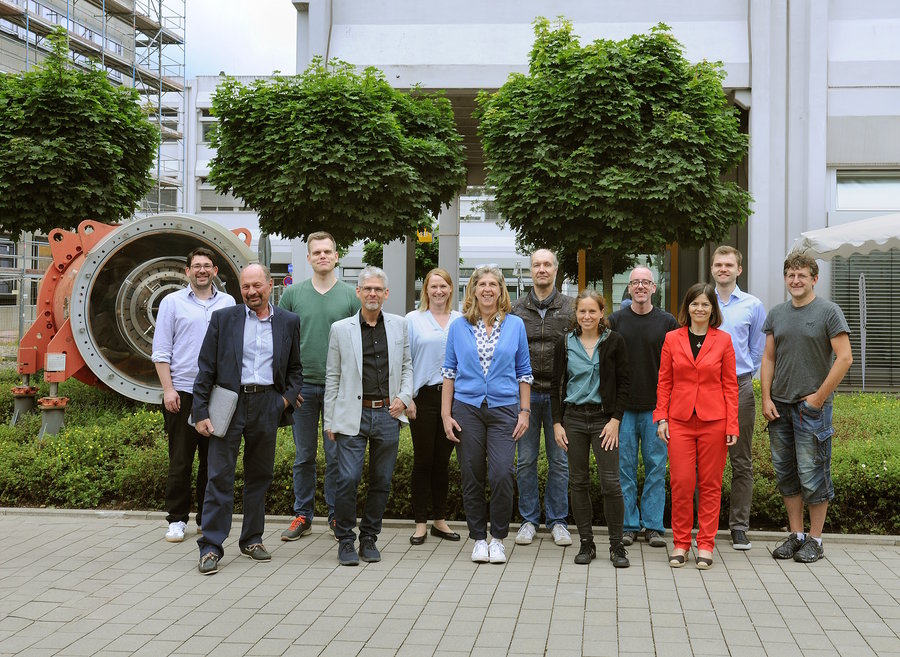Workshop at GSI on radiation hardness testing: Focus on the needs of research and industry
18.09.2024 |
The topic of radiation hardness testing was the focus of a workshop recently organized by the GSI Helmholtzzentrum für Schwerionenforschung together with the two GSI use case initiatives of the Helmholtz innovation platform Hi-Acts and Datzmann Interact & Innovate (DINI) as a leading service provider in the field of radiation hardness testing. The key topics were the current status, best practices, challenges and future opportunities on the GSI campus. The event brought together stakeholders from different departments, experts and perspectives from GSI as well as external institutions and users. The objective was to develop a better understanding of the existing technical possibilities and developments, the needs of industry and research and future prospects in the field of radiation hardness testing.
The workshop focussed on two projects funded by Hi-Acts, the innovation platform for accelerator-based technologies and solutions: GSI Biophysics' "Standardised Station for High-energy Heavy Ion Radiation on Electronics" project and GSI Materials Research's "Microprobe 2.0" project. Both initiatives mark significant progress in the field of radiation hardness testing for space electronics.
For space missions to the moon and beyond, the complex radiation environment in space can be a limiting factor for space exploration. The ionizing radiation can affect electronic devices and components. Therefore, mission-critical systems must be tested for radiation hardness before being used in space.
The ground based broad beam heavy ion characterization of electronics is currently done with low energy ions, typically at the accelerators in Louvain (Belgium) and Jyväskylä (Finland). Considering the particle range at these low energy facilities (several tens of µm), some electronic devices undergo complex and invasive sample preparation to expose their most sensitive or critical components to the ion beams. To test the electronics at low energy accelerators, complex and invasive sample preparation is needed to expose the critical components to the ion beams considering the limited particle range of ~100 µm. Whilst in the past electronics was customized for the specific mission, and therefore different sub-components could be tested seperately, nowadays space agencies tend to use commercial components-off-the-shelf (COTS). Testing COTS, which cannot be disassembled, requires heavy ions with range in silicon >1 mm. In Europe, this is only possible at GSI. Therefore, we have a potential wide market request from European space industry to test their modern electronics with the high energy (SIS18, and in the future SIS100) beams at GSI and FAIR, which provide up to U ion beams with energies up to 1 and 10 GeV/u, respectively. These beams are also of interest since Galactic Cosmic Rays (GCR) contain heavy ions at energies above 100 MeV/n.
The Hi-Acts Use Case Initiative project carried out by the Biophysics Department at GSI in 2023 made a significant contribution to the development of a standardized procedure for the assembly, positioning and irradiation of electronic samples. This development represents a significant step towards automation and standardization in the testing of space electronics with high-energy heavy ion beams, leading to standard workflow for external industrial users. Resources will be saved and work will be more efficient, which will benefit the entire space industry.
Compared to broad beams, the existing heavy ion microprobe at GSI’s linear accelerator UNILAC enables the injection of charge carriers into spatially defined locations in integrated circuits for radiation hardness testing of detectors and electronics with heavy ion micro beams. The UNILAC ion beam energies of up to 11 MeV/u provide a penetration range in the materials of up to 100 µm. The microprobe focuses ions from the linear accelerator into a focal spot of about 500 nanometers diameter and positions individual ions across the target. The effect of each individual event at its defined location in the electronic device is registered to compile a map of radiation sensitivity.
Using the heavy ion microprobe, users and developers can determine the localized effects of dense ionizing radiation on electronic devices, such as those on their way to space qualification. The current GSI’s material research project “Microprobe 2.0” will upgrade the hardware and software systems of the current microprobe to a unique and user-friendly single-event effect test system for integrated electronic circuits. The project will facilitate industry access to GSI’s linear accelerator UNILAC to carry out their own high-resolution electronic tests with ion micro beams more efficiently, with remote support from specialists.
During the workshop, GSI presented the results of the recent microelectronics testing campaign performed by ESA and EU projects. Participants received an insight into the European radiation hardness testing landscape as well as the expectations and needs of industrial users from Gerd Datzmann (DINI). One highlight was the presentation by Ruben Garcia Alia (CERN) on best practices in the field of radiation hardness testing. He shared his experiences from the two EU projects RADNEXT and HEARTS, both in cooperation with GSI, and explained the background to the creation of the R2E (Radiation to Electronics) project at CERN.
During the workshop, technical and scientific boundary conditions were discussed in line with the requirements of potential users from industry and research. Approaches were discussed as to how these requirements can be aligned in the future in order to drive innovation and overcome challenges in radiation hardness testing. (BP)
Further information













